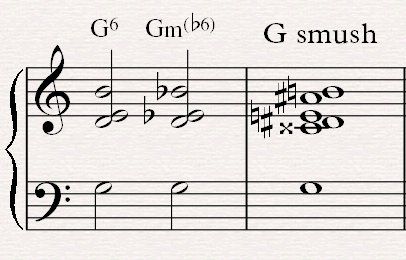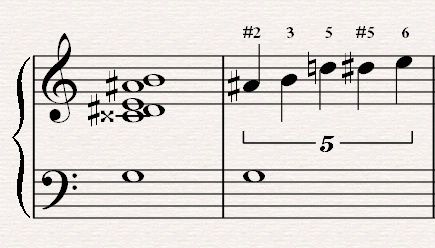One of my current jobs is as a rehearsal accompanist for a production of Leonard Bernstein's West Side Story. This means I attend rehearsals with the singers/actors/dancers and play whichever piece of music they are working on. And that means that one night I may be teaching pitches for a new song, but on another night, I might be playing an entire dance number so that the dancers can work on their choreography along with live music.
All of this meaning: I have a lot of music to learn, and it's to the benefit of everyone involved that I learn this music very thoroughly. I'm up for the challenge! Part of this thorough learning, on my part, means that I'm analyzing some of the music theory behind Bernstein's music.
Knowing the motifs (recurring musical ideas) and harmonic structures of the music helps a great deal with learning it more efficiently and more thoroughly—at least for me, anyways!
The "Smush Chord"
I'm calling this blog series "West Side Score-y" (A Score Study of West Side Story). Hilarious, I know. This first part addresses what I am calling the "Smush Chord."
Here's what it looks like on the printed page:
 |
| Excerpted from "Jet Song" |
The visual and aural harshness of the chord is part of what made me want to analyze it a bit deeper and try to wrap my head around it.
(To be honest, sometimes my instinct when seeing a chord like this, is to just smash my hand down onto the keyboard and hope for the best. This more measured, analytical approach is an effort to avoid that tactic.)
Pitch Inventory
Here's the chord's pitches re-ordered according to ascending (G major) scale order. Above each note, I've attached a scale-degree label, based on the G major scale. I have used some enharmonic spellings in the analysis.
*Notice the tritone (diminished 5th) interval between A# and E. West Side Story is riddled with tritones (Think: "Ma-ri-a").
Major + Minor = Smush
I noticed that the chord's pitches can be divided into two separate groups, one of which forms a Major 6 chord, and the other of which forms a Minor chord (with a flattened 6). Keep in mind, I'm adding the bass note "G" in order to create these chords (indeed, G is the root note).
 |
| G6 + Gm(b6) = G smush |
Why?
Why discuss this? Frankly, because it helps. Personally, knowing where the chord tones come from, and how they relate to a familiar tonality helps me wrap my head (and my fingers) around the chord. Furthermore, I knew it was a chord worth exploring because I noticed it shows up at other places throughout the score.
More generally, the half steps (and tritones!) found within this chord are extremely characteristic of Bernstein's intensely chromatic writing throughout the musical. (More on that later.)
Stay tuned for additional installments of "West Side Score-y," which will be created the next time I run into a similarly intriguing musical morsel!


No comments:
Post a Comment